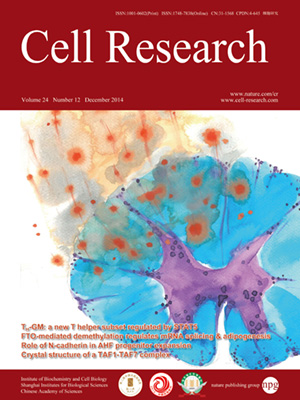
Volume 24, No 12, Dec 2014
ISSN: 1001-0602
EISSN: 1748-7838 2018
impact factor 17.848*
(Clarivate Analytics, 2019)
Volume 24 Issue 12, December 2014: 1493-1496
LETTERS TO THE EDITOR
Crystal structure of the YTH domain of YTHDF2 reveals mechanism for recognition of N6-methyladenosine
Tingting Zhu1, Ian A Roundtree2, Ping Wang1, Xiao Wang3,4, Li Wang1, Chang Sun1, Yuan Tian1, Jie Li1, Chuan He3,4 and Yanhui Xu1
1Fudan University Shanghai Cancer Center, Department of Oncology; and Institute of Biomedical Sciences and School of Basic Medical Sciences, Shanghai Medical College of Fudan University, Shanghai 200032, China
2Medical Scientist Training Program and Department of Biochemistry and Molecular Biology, The University of Chicago, Chicago, IL 60637, USA
3Department of Chemistry and Institute for Biophysical Dynamics, The University of Chicago, Chicago, IL 60637, USA
4Howard Hughes Medical Institute, The University of Chicago, Chicago, IL 60637, USA
Correspondence: Yanhui Xu,(xuyh@fudan.edu.cn)
N6-methyladenosine (m6A) has been demonstrated to be ubiquitous in several types of eukaryotic RNAs, including messenger RNA (mRNA), transfer RNA (tRNA), ribosomal RNA (rRNA), long non-coding RNA (lncRNA), and small nuclear RNA (snRNA)1. The recent discoveries of RNA m6A methyltransferase complex METTL3/METTL14/WTAP and demethylases FTO and ALKBH5 prove the reversibility of m6A modification2,3,4,5,6. This modification plays important roles in various biological processes, including circadian rhythms7, RNA splicing8,
10.1038/cr.2014.152
FULL TEXT | PDF
Browse 2136


